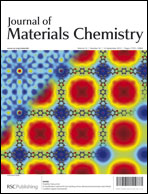A facile method was developed to fabricate hollow amino-functionalized organosilica microspheres based on the hydrolysis and condensation of 3-aminopropyltriethoxysilane (APTES) and tetraethoxysilane (TEOS) in an aqueous system without an additional template and catalyst. The hollow hybrid organosilica microspheres obtained have been characterized by scanning electron microscopy, transmission electron microscopy, and N2 adsorption–desorption measurements. The results of Fourier transform infrared spectroscopy, solid-state NMR spectroscopy, X-ray photoelectron spectroscopy and thermogravimetric analysis displayed the composition of the synthesized hollow microspheres and the presence of amino groups on the surface. A self-templated and self-catalyzed mechanism for the formation of the hollow microspheres is proposed: the protonated APTES acts as both a catalyst for the reaction and a stabilizer for the hydrophobic precursor droplets, while the droplets themselves act as soft templates, and the consumption of the precursors leads to the formation of a hollow structure. The morphology and the size distribution of the organosilica microspheres can be controlled by tuning the composition of the precursors, and the stirring speed, as well as the reaction temperature. The large cavity with an open hole on the shell and the reactive amino groups on the surface of the hybrid organosilica microspheres promise many potential applications. Examples of employing the microspheres as adsorbents and phase change microcapsules have been presented.

You have access to this article
 Please wait while we load your content...
Something went wrong. Try again?
Please wait while we load your content...
Something went wrong. Try again?


 Please wait while we load your content...
Please wait while we load your content...